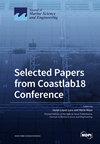梯度提升树和去噪自动编码器修正数值波浪预报
IF 2.8
3区 地球科学
Q1 ENGINEERING, MARINE
引用次数: 0
摘要
本文致力于修正 WAM/ICON 数值波浪模型的预测结果,减少模型预测结果与实际浮标观测结果之间的残差。本文使用的两个参数是显著波高和风速。本文提出了两个机器学习模型来解决这一任务。这两个模型都是多输出模型,可同时修正显波高度和风速。第一个机器学习模型以梯度提升树为基础,利用数值模型预测的其他参数作为输入,训练该模型预测模型预测值与实际浮标观测值之间的残差。本文证明,该模型可显著减少所有使用地理位置的误差。本文还使用 SHapley Additive exPlanation 值来研究机器学习模型预测残差时数值预测波浪参数的影响。在设计第二个模型时,假定残差可被模拟为添加到实际值中的噪声。因此,本文建议使用去噪自编码器来去除数值模型预测中的噪声。结果表明,去噪自编码器可以去除风速参数的噪声,但在显著波高参数上性能较差。本文解释了出现这种情况的原因。本文章由计算机程序翻译,如有差异,请以英文原文为准。
Gradient Boosted Trees and Denoising Autoencoder to Correct Numerical Wave Forecasts
This paper is dedicated to correcting the WAM/ICON numerical wave model predictions by reducing the residue between the model’s predictions and the actual buoy observations. The two parameters used in this paper are significant wave height and wind speed. The paper proposes two machine learning models to solve this task. Both models are multioutput models and correct the significant wave height and wind speed simultaneously. The first machine learning model is based on gradient boosted trees, which is trained to predict the residue between the model’s forecasts and the actual buoy observations using the other parameters predicted by the numerical model as inputs. This paper demonstrates that this model can significantly reduce errors for all used geographical locations. This paper also uses SHapley Additive exPlanation values to investigate the influence that the numerically predicted wave parameters have when the machine learning model predicts the residue. To design the second model, it is assumed that the residue can be modelled as noise added to the actual values. Therefore, this paper proposes to use the denoising autoencoder to remove this noise from the numerical model’s prediction. The results demonstrate that denoising autoencoders can remove the noise for the wind speed parameter, but their performance is poor for the significant wave height. This paper provides some explanations as to why this may happen.
求助全文
通过发布文献求助,成功后即可免费获取论文全文。
去求助
来源期刊

Journal of Marine Science and Engineering
Engineering-Ocean Engineering
CiteScore
4.40
自引率
20.70%
发文量
1640
审稿时长
18.09 days
期刊介绍:
Journal of Marine Science and Engineering (JMSE; ISSN 2077-1312) is an international, peer-reviewed open access journal which provides an advanced forum for studies related to marine science and engineering. It publishes reviews, research papers and communications. Our aim is to encourage scientists to publish their experimental and theoretical results in as much detail as possible. There is no restriction on the length of the papers. The full experimental details must be provided so that the results can be reproduced. Electronic files and software regarding the full details of the calculation or experimental procedure, if unable to be published in a normal way, can be deposited as supplementary electronic material.
 求助内容:
求助内容: 应助结果提醒方式:
应助结果提醒方式:


